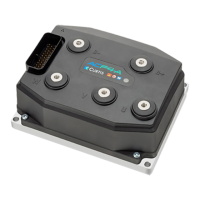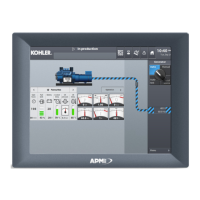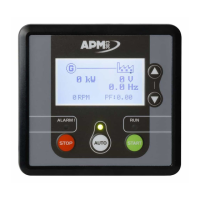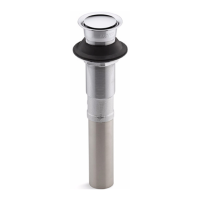6 — COMMISSIONING
pg. 169
Return to TOC Curtis AC F2-A, F4-A, F6-A Motor Controllers – FOS 4.5 – April 2022
9.4 e direction source is set using the Direction Source parameter. See Programmer » Application
Setup » rottle » Direction Source. Here, the source will be the Fwd/Rev selection if the
switches are selected as noted in step 9.1. Alternatively, if voltage determines the direction,
select Wig/Wag (wigwag throttle).
9.5 If the throttle will be via VCL, enable VCL rottle. Programmer » Application Setup » rottle
» VCL rottle Enable.
e VCL rottle provides a dierent way of sending the throttle command to the controller.
is throttle type uses VCL to dene the throttle signal that will be “input” into the throttle
signal chain as VCL_rottle.
See Programmer » Controller Setup » IO Assignments » Controls » rottle Source = 0
e VCL program/coding will determine the source of the throttle signal, making this a very
exible throttle input method. VCL can be written to use any of the controller’s analog inputs
or CAN communication messages (e.g., from a vehicle manager controller) as the source of the
throttle signal.
Setting the throttle to the parameter VCL rottle Enable (On) re-assigns (frees) the throttle
pot input for uses other than throttle input.
For questions regarding this throttle type, contact the Curtis distributor or support engineer.
3-wire potentiometer throttle
When a 3-wire potentiometer is used, the controller provides full fault protection in accordance
with EN 1175-1 requirements. In its voltage divider mode, the controller provides the voltage source
and the potentiometer return/ground. e Pot Supply circuit provides a current limited to 5 volts to
the 3-wire potentiometer, and pin 18 or 7, I/O Ground, provides the return path. is is the 3-wire
potentiometer throttle shown in the basic wiring diagram (Figure 13, Chapter 2) and Figure 36, below.
If any of the three connections open, it triggers a rottle Input fault (ash code 4-2).
e Curtis throttle FP-10 model is a 0–5 kΩ 3-wire potentiometer throttle. It oers, besides the
controller’s 3-wire fault detection, two throttle spring (position) detection switches, two neutral and
two full throttle position switches. is throttle is congurable as a 0–5k Ω or 5k–0 Ω potentiometer.
1kΩ –10kΩ
FASTER
I/O Ground (Pin 7)
Pot 6 Supply (Pin 15)
Pot 1 Wiper input (Pin 16)
3-wire Potentiometer Source
Figure 36
Wiring for 3-Wire
Potentiometer throttles
2-wire potentiometer throttle
For 2-wire resistive potentiometers, shown in Figure 37, full throttle request corresponds
to 0 Ω measured between the pot wiper and the I/O Ground. A 2-wire throttle requires the
Forward & Reverse Min Input parameters to be set towards a higher percentage (e.g., 95%) and
the Forward & Reverse Max Input parameters set to a lower percentage (e.g., 5%). Note that this is

